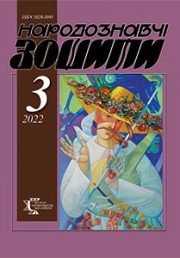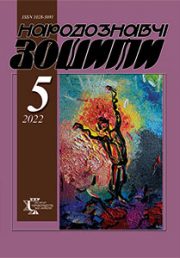The Ethnology Notebooks. 2020. № 5 (155), 1081—1096
UDK 7. 046; 7.041.6
DOI https://doi.org/10.15407/nz2020.05.1081
KOSIV Roksolana
- ORCID ID: http://orcid.org/0000-0002-1202-1488
- Doctor in Art Studies,
- Associate professor, Lviv National Academy of Arts
- Senior scholar, National Museum in Lviv named afterAndrey Sheptytsky
- 20, Svobodyav., 79008, Lviv, Ukraine
- Contacts: e-mail: lanakosiv@yahoo.com
Abstract. Problem statement. The study of icons of one stylistic group is an important research area of the 15th—19th centuries in Ukrainian art. Since the vast majority of icons are anonymous, such research is basic for studying the activities of individual painters and iconpainting centers. The study of icons in churches, as well as the study of museum collections, expands knowledge about Ukrainian iconpainting and allows us to go beyond the limited range of works circulating in popular or even scientific publications. In this context, 56 icons of the 17th — first half of the 18th century from the churches in Voinyliv (Ivano-Frankivsk region) stored in the Andrei Sheptytskyi National Museum in Lviv were studied. These icons have never been considered comprehensively and most of them have not been published.
The purpose of the article is to systematize the 17th — first half of the 18th centuries icons from the Voinyliv churches by the manner of painting, to correlate the descriptions of icons from the documents of 18th-century church visits with specific works to reconstruct the original locations, and call attention to works painted by one master belonging to the same iconostasis.
The methods of formal and iconographic analysis, the method of reconstruction are used in the research. The icons are analyzed with the consideration of the cultural context.
Results. The group of the first half of the 17th century icons, originating from the Nativity of the Virgin and the Nativity of Christ churches in Voinyliv reveal a connection with Lviv iconpainting school, what testifies that their authors could have a connection with this school or belong to it. The late 17th — beginning of the 18th centuries icons which we associate with the St. Nicholas church, as well as a set of festive icons and icons of the prophets, have a slightly different style of painting, which finds analogues with the icons from the churches of Bolokhiv, Zavadka, and Dolyna. The peculiar style of painting of these icons allows us to confirm the hypothesis of the existence of a local iconpainting center.
Conclusions. The 17th century icons from Voinyliv expand the geography of influences of the first half of the 17th century leading Lviv iconpainting school and also allow us to talk about the spread of common for Ukrainian iconpainting of the second half of the 17th century of Lviv and Peremyshl dioceses trends by local masters.
Keywords: icon, iconostasis, painting center, church art, Voinyliv, documents of church visits.
Received 25.09.2020
REFERENCES
- Patriarch Dymytriy (Yarema). (2005). Western Ukrainian iconpainting of the 12th—15th centuries. Lviv [in Ukrainian].
- Patriarch Dymytriy (Yarema). (2017). Western Ukrainian iconpainting of the 16th — first half of the 17th centuries. Lviv [in Ukrainian].
- Sventsitska, V., & Sydor, O. (1990). Heritage of the ages. Ukrainian painting of the 14th— 18th centuries in the Lviv museum collections. Lviv [in Ukrainian].
- Helytovych, M. (2005). The otokos with Child and with praise. Ikons from the collection of the National museum in Lviv named after Andrei Sheptytskyi. Lviv [in Ukrainian].
- Kosiv, R. (2020). «The Virgin Eleusa with the Tree of Jesse» icon of the late 17th century from the Voinyliv church in Ivano-Frankivsk region: motives and symbols of iconography. National Academy of Culture and Arts Management Нerald: Science journal, 2, 94—98) [in Ukrainian].
- Kolos, O. (2006). Three icons on canvas from Voinyliv (from the collection of the former museum of the Theological Academy). Ukrainian Greek Catholic Church and religious art (historical experience and the problem of modernity). Proceedings of the IV International Scientific Conference, 4, 177—183 [in Ukrainian].
- Kolos, O. (2007). Icon «Mary of Egypt» from Voinyliv: iconography and art analysis. Fine Art, 2, 100—101 [in Ukrainian].
- Kosiv, R. (2016). «The Passion of the Christ» icons on the canvas of the 17th century from the collection of the Andrei Sheptytskyi National Museum in Lviv. Art Studies: Fine and Decorative Arts. Architecture (Part 2, pp. 27—46). Kyiv [in Ukrainian].
- Kosiv, R. (2019). Icons on canvas «The Tree of Jesse» of the second half of the 17th century from the Andrei Sheptytskyi National Museum in Lviv in the context of subject development. The Ethnology Notebooks, 6, 1379—1392 [in Ukrainian].
- Melnyk, V. (2007). Sacred art of Halychyna of the 15th—20th centuries in the exposition of the Ivano-Frankivsk Art Museum. Ivano-Frankivsk [in Ukrainian].
- Sydor, O. (2012). Patriarch Yosyf Slipyi and the art. Lviv; Rome [in Ukrainian].
- (1907). Shematyzm of the entire Greek-Catholic clergy of the Lviv Metropolitan Archdiocese on the 1907 year. Zhovkva [in Ukrainian].
- (1927). Shematyzm of the Greek-Catholic clergy of the Lviv Archdiocese on the 1927 year. Lviv [in Ukrainian].
- (1932). Shematyzm of the Greek-Catholic clergy of the Lviv archdiocese on the 1932/33 years. Lviv [in Ukrainian].
- (1930). Shematyzm of the Greek-Catholic clergy of the Lviv Archdiocese on the 1930 year. Lviv [in Ukrainian].
- Yurkevych, Yu. (Ed.). (2012). The royal doors of the Ukrainian iconostasis. Album. Lviv [in Ukrainian].
- Kosiv, R. (2009). The Ukrainian banners. Kyiv [in Ukrainian].
- Sventsitsky, I. (Ed.). (1908). Description of the Museum of the Stauropegion Institute in Lviv. Lviv [in Ukrainian and Russian].
- Sharaniewich, I. (1888). Catalog of the Archaeological and Bibliographic Exhibition of the Stauropegion Institute in Lviv. Lviv [in Polish].
- Sharanevich, I. (1889). Report from the Archeological and bibliographic exhibition at the Stauropegion Institute, opened on September 28 (October 10), 1888, closed on February 16 (28), 1889, and an description of photographs of objects taken at the same exhibition. Lvov [in Russian].
- Melnyk, V. (1991). Church of the Holy Spirit in Rohatyn. Album. Kyiv [in Ukrainian].
- Aleksandrovych, V. (2013). Masters of «small» centers of Ukrainian painting of the historical Peremyshl-Lviv region of the first half of the 17th century. Society Almanac of Social History (Issue 10, pp. 9—30). Kyiv [in Ukrainian].
- Aleksandrovych, V. (1998). From studies on written sources to the history of Ukrainian art. Painters in the artistic relations of the western Ukrainian lands of the 16th—17th centuries. Notes of the Shevchenko Scientific Society. Proceedings of the Commission of Fine and Applied Arts (Vol. CCXXXVI, pp. 516—540). Lviv [in Ukrainian].
- Sydor, О., & Lozynskyi, Т. (Ed). (2003). Ancient Ukrainian icon: from private collections. Kyiv [in Ukrainian].
- (1733). Visit of the Voinyliv deanery in 1733. Andrey Sheptytskyi National Museum in Lviv. Department of Manuscripts and old printed books (Ркл-11) [in Polish].
- (1740). Visit of the Halych deanery in 1740. Andrey Sheptytskyi National Museum in Lviv. Department of Manuscripts and old printed books (Ркл-16) [in Polish].
- (1753). Visit of the Halych deanery in 1753. Andrey Sheptytskyi National Museum in Lviv. Department of Manuscripts and old printed books (Ркл-18) [in Polish].
- Pelech, M. (2011). A newly discovered monument of Galician painting of the middle of the 17th century — a «Passions of Christ» cycle from the Synaxis of the Virgin church in the Batyatychi village. Apolohet. Christian sacred tradition: faith, spirituality, art. Theological digest of the Lviv Theological Academy. Proceedings of the Third international scientific conference, Lviv, 24—25 November 2011 (Pp. 118—123). Lviv [in Ukrainian].
- Aleksandrovych, V. (2011). «Brotherly aspect» of the Lviv painting history of the first half of the 17th century. Apolohet. The Lviv Stauropegic Brotherhood of the Assumption of the Virgin in Ukrainian spiritual culture (on the 425th anniversary of obtaining patriarchal stauropegia by the Lviv Stauropegion Brotherhood). Proceedings of the Third international scientific conference, Lviv, 26 May 2011 (Pp. 28—40). Lviv [in Ukrainian].







